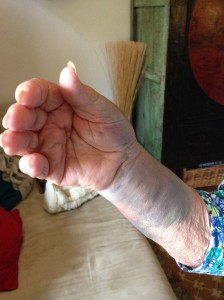Last week my 86 year old mother fell over an uneven paving slab on her way back from the library.  The swelling and bruising came out immediately and fortunately her wrist which took the impact of the fall wasn’t broken.
The swelling and bruising came out immediately and fortunately her wrist which took the impact of the fall wasn’t broken. 
She was badly shaken up by the event and took to her bed as a result.
Living in a location where a good number of the 100k residents are past retirement age according to a 2013 article Seaside town first place in country with average age of more than 70 and with many suffering impaired vision I decided to report the incident in the hope that the pavement might be fixed qucikly.
I was pleasantly surprised to discover a facility built on a Google Maps platform for reporting damaged pavements on the local government website (in 8 languages) and a twitter feed for instant access. So far so good.
The automatic response to my filing (and picture) was likewise encouraging and included the phrase ‘we will investigate’ along with a reference so I could track the progress.
Thinking of making a claim
Please consider the following points before you submit a claim. Making a claim can be a lengthy process and may not result in a pay-out. Any compensation is paid from public money so we will always be robust in our investigation of claims. The decision on liability will be based on the facts of each case and the law. Because of the legal defence available, on average, 70% of claims are unsuccessful.
The last sentence (my underlining) is instructive and made me ponder whether the use of the technology is for offensive or defensive purpose? Have we become such a litigious society that every corporate body feels compelled to get their retaliation in first and use social media as a broadcast and defensive mechanism not a collaborative platform?
I digress. Let’s be charitable and assume good intentions and applaud this as an example of good knowledge capture and retention. What we don’t as yet know is whether this will become a good example of how knowledge can be put to good effect and improve a process (or in this case fix something that isn’t working).
When Knowledge becomes an asset
Most organisations go down the Knowledge Capture route – they create buckets (increasingly in SharePoint) to store what they have captured to make sure that the best knowledge is available when a bid, a presentation or a decision is to be made. And that’s fine as far as it goes. Rarely do organisations add on the Knowledge Harvesting step. Here’s what that entails (drawn from Knowledge Associates’ 9 Step KM Process that acknowledges and builds on the original BP model of learning before, during & after):
- Conduct a learning or After Action Review
- At the end of that process ask the question does what we have discovered have the power to change/improve the way we (and those associated with us) work?
- If the answer is yes then you have what is known as a Knowledge Nomination and these should be considered at a separate gathering.
- Now convene, if you don’t have one as part of a Community of Practice, virtually or in person, a group of Subject Matter Experts with expertise on the process or way of working. Ask them to consider whether the Knowledge Nomination will improve our process and should be adopted.
- If they agree then change the process. If they don’t then make sure you have captured the Knowledge Nomination and the reason for its rejection.
I have always believed that the purpose of Knowledge Management is to help organisations make better decisions and work more effectively. The simple steps I’ve outlined above should help in acheiving those objectives.
I wait now with interest to see the outcome of the saga of the loose paving slab. Will the outcome merely be a repaired section of pavement or will the team think about how this was caused and put in place measures to stop it happening next time?
